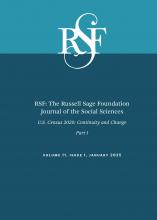Research Article
Open Access
Unstable Work Schedules and Racial Earnings Disparities Among U.S. Workers
Julie Y. Cai, Marybeth J. Mattingly
RSF: The Russell Sage Foundation Journal of the Social Sciences January 2025, 11 (1) 201-223; DOI: https://doi.org/10.7758/RSF.2025.11.1.10
Julie Y. Cai
aEconomist at the Center for Economic and Policy Research, United States
Marybeth J. Mattingly
bAssistant vice president for the Federal Reserve Bank of Boston’s Regional & Community Outreach Department, United States

REFERENCES
- ↵
- ↵
- Aladangady, Aditya,
- Andrew C. Chang, and
- Jacob Krimmel
- ↵
- Alexander, Charlotte, and
- Anna Haley-Lock
- ↵
- Ananat, Elizabeth O.,
- Anna Gassman-Pines, and
- John A. Fitz-Henley
- ↵
- Bandelj, Nina, and
- Angelina Grigoryeva
- ↵
- Brown, Alexandra,
- David Buchholz,
- Matthew B. Gross,
- Jeff Larrimore,
- Ellen A. Merry,
- Barbara J. Robles,
- Maximilian D. Schmeiser, and
- Logan Thomas
- ↵
- Cai, Julie
- ↵
- Cai, Julie Y., and
- Shawn Fremstad
- ↵
- Cai, Julie,
- Christopher Wimer,
- Lawrence Berger, and
- Matthew Maury
- ↵
- Chaganti, Sara,
- Erin Graves,
- Amy Higgins,
- Marybeth Mattingly,
- Sarah Savage, and
- Catherine Tonsberg
- ↵
- ↵
- ↵
- Clawson, Dan, and
- Naomi Gerstel
- ↵
- Couch, Kenneth, and
- Mary C. Daly
- ↵
- Deitch, Elizabeth A.,
- Adam Barsky,
- Rebecca M. Butz,
- Suzanne Chan,
- Arthur P. Brief, and
- Jill C. Bradley
- ↵
- ↵
- Finnigan, Ryan, and
- Jo Mhairi Hale
- ↵
- Finnigan, Ryan, and
- Savannah Hunter
- ↵
- Flood, Sarah,
- Miriam King,
- Renae Rodgers,
- Steven Ruggles,
- J. Robert Warren, and
- Michael Westberry
- ↵
- ↵
- Golden, Lonnie
- ↵
- Goldin, Claudia, and
- Lawrence F. Katz
- ↵
- Goubert, Anais,
- Julie Yixia Cai, and
- Eileen Appelbaum
- ↵
- Gould, Elise, and
- Melat Kassa
- ↵
- Hacker, Jacob S
- ↵
- Hardy, Bradley,
- Charles Hokayem, and
- Stephen Roll
- ↵
- ↵
- ↵
- Howell, David R., and
- Arne L. Kalleberg
- ↵
- Kalleberg, Arne L
- ↵
- Kalleberg, Arne L.,
- Barbara F. Reskin, and
- Ken Hudson
- ↵
- LaBriola, Joe, and
- Daniel Schneider
- ↵
- Lambert, Susan J
- ↵
- Lambert, Susan J.,
- Peter J. Fugiel, and
- Julia R. Henly
- ↵
- Lambert, Susan J., and
- Julia R. Henly
- ↵
- Lane, Julia
- ↵
- Loustaunau, Lola,
- Larisswa Petrucci,
- Amelia Coffey,
- Eleanor Lauderback,
- H. Elizabeth Peters,
- Ellen Scott, and
- Lina Stepick
- ↵
- ↵
- Morduch, Jonathan, and
- Rachel Schneider
- ↵
- Morduch, Jonathan, and
- Rachel Schneider
- ↵
- Mouw, Ted, and
- Arne L. Kalleberg
- ↵
- National Employment Law Project (NELP)
- ↵
- ↵
- Pager, Devah, and
- Hana Shepherd
- ↵
- Pedulla, David S., and
- Devah Pager
- ↵
- ↵
- Quillian, Lincoln,
- Devah Pager,
- Ole Hexel, and
- Arnfinn H. Midtbøen
- ↵
- Ruetschlin, Catherine, and
- Dedrick Asante-Muhammad
- ↵
- Schneider, Daniel
- ↵
- ↵
- Schweitzer, Justin, and
- Rose Khattar
- ↵
- ↵
- Stainback, Kevin, and
- Donald Tomaskovic-Devey
- ↵
- Storer, Adam,
- Daniel Schneider, and
- Kristen Harknett
- ↵
- Swanberg, Jennifer E.,
- Elizabeth Watson, and
- Meridith Eastman
- ↵
- U.S. Department of Labor
- ↵
- Warren, Lewis, and
- Alexander Tettenhorst
- ↵
- Western, Bruce, and
- Jake Rosenfeld
- ↵
- Wilson, Valerie, and
- William M. Rodgers III.
- ↵
- Wolf, Sharon,
- Lisa A. Gennetian,
- Pamela A. Morris, and
- Heather D. Hill
- ↵
- Wood, Alex J
- ↵
- Ziliak, James P.,
- Bradley Hardy, and
- Christopher Bollinger
In this issue
Unstable Work Schedules and Racial Earnings Disparities Among U.S. Workers
Julie Y. Cai, Marybeth J. Mattingly
RSF: The Russell Sage Foundation Journal of the Social Sciences Jan 2025, 11 (1) 201-223; DOI: 10.7758/RSF.2025.11.1.10
Jump to section
Related Articles
- No related articles found.
Cited By...
- No citing articles found.





